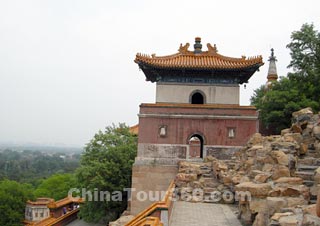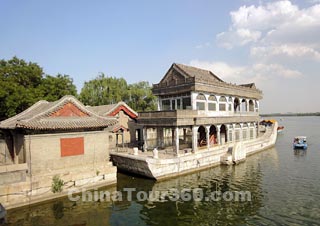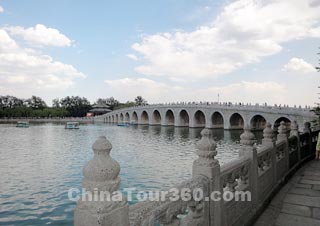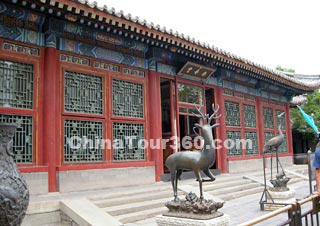Self-guided Summer Palace Tour
"Route from North Palace Gate"
- Code: SP02
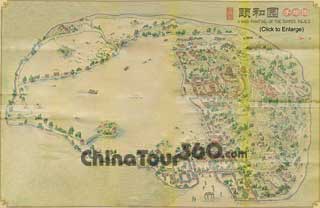 |
| Summer Palace Map |
Summer Palace is known as the paragon of imperial gardens. It is a masterpiece of garden art that successfully represents harmony of man and nature. It will take you about three hours to finish this Summer Palace tour.
First we come to the North Palace Gate, one of the important palace gates in the Summer Palace, which is located at the north of Suzhou Market Street. It is a two-story building with a gable roof. Emperor Qianlong used to inspect troops of Eight Banners at this gate tower.
At the backside of the gate, it is Suzhou Market Street next to the Longevity Hill. The street was built imitating the water towns along the Yangtze River, commanded by Emperor Qianlong who intended to please his concubines. With a length of around 300 meters, there are more than 200 shops including Tea house, wine house, old-fashioned Chinese private bank, drugstore, pawnshop and traditional bookstore. The shop assistants and some so-called tourists dress like eunuchs and maids. It is also the Merchants Street.
Behind the Longevity Hill, there is a Tibetan Style Temple complex, namely Four Great Regions (Sida Buzhou), which was first built in the reign of Emperor Qianlong, destroyed by Anglo-French Allied Forces in 1860 and rebuilt by Empress Dowager Cixi in 1888, afterward perfected by the New China government in 1980. Since the instability arose among the minority people early in the Qing Dynasty, besides using the military force, Emperor Qianlong built Lamaseries on a large scale to appease the people who believed in the Buddhism. This policy was very effective at that time.
Standing on the top of the Longevity Hill, the Tower of Buddhist Incense is the highest building in the Summer Palace and the symbol of it. It is the best place for travelers to overlook Kunming Lake, Yuquan Hill and the pagoda. The Empress Dowager Cixi used to worship the Buddha and pray for peace at the tower.
The Hall of Dispelling Clouds lies in the front of the Longevity Hill. The Hall was named the Temple of Gratitude for Longevity (Dabaoen Yanshousi) which was built by Emperor Qianlong for celebration of his mother’s sixtieth birthday.
|
|
Walking south to pass the Gate of Dispelling Clouds, travelers will reach the Long Gallery, a colorful road. There are more than 14,000 paintings on the ceiling of the Gallery. Most of the paintings depict the famous stories from the Chinese classic novels.
The Marble Boat (Qingyan Boat or Clear and Peaceful Boat) is situated at the backside of Shizhang Pavilion which is the westernmost end of the Long Gallery. The Chinese saying that “the water that bears the boat is the same that swallows it up”, which shows that Emperor Qianlong built this stone boat in the water to indicate that the rule of Qing Dynasty (1644-1911) is as firm as a rock.
From the bank near the Marble Boat, you could continue your Summer Palace tour to take a ferry to Nanhu Island (South Lake Island), which is the biggest island in Kunming Lake. Only Big Boat is available from this dock. Standing at the north side of the Island, the Hanxu Hall is the main construction at the island, which has been the place where the emperors and empresses watched the marine performance.
The Seventeen-Arch Bridge connects Nanhu Island and Dong Di (East Causeway of Kunming Lake). After walking across the Bridge, travelers can see the famous Bronze Ox lying at the bank, which is the biggest existent plated bronze ox in China. Emperor Qianlong made this statue following the ancient story of "King Yu Combating the Flood" to pray for blessing of the Summer Palace and the people.
|
|
Wenchang Gallery, a quadrangle-like exhibition hall, is located north of the East Causeway. The Gallery was founded in 1998 and finished in 2000, consisting six exhibition zones covering bronze, jade, porcelain, horologe, painting and calligraphy. The fine and very rare Three Sheep Vase (Shang Dynasty, 1600 B.C.-1046 B.C.) and the Bai Vessel (Xi Zhou Dynasty, 1046 B.C.-771 B.C.) in the hall are valuable cultural relics in the Summer Palace.
Travelers will arrive at the Hall of Jade Ripples after walking north along the Causeway. It was first built in 1750 and used as the study room for Emperor Qianlong and Emperor Jiaqing. During the Qing Dynasty Emperor Guangxu Period, the emperor lived here, and after the failure of the Reform Movement of 1898, he was held here in captivity by the Empress Dowager Cixi. In the front of the hall, there are two stones, which were moved from the Jingyi Garden (present Fragrant Hills) by the Empress Dowager Cixi who called them "mother and child" to admonish Emperor Guangxu for not forgetting her power.
Yiyun House is situated north of the Hall of Jade Ripples. It was the residence for Empress Yulong who was Emperor Guangxu's wife. Yulong was crowned Empress in 1889, but she was all the while at variance with the Empreor. She was a niece of Empress Dowager Cixi, namely a cousin of Emperor Guangxu. Empress Dowager Cixi compelled them to be married in order to better control the Emperor. Both Guangxu and Yulong were actually victims of politics. The fitment with precious stone and tiny bamboo sticks in Yiyun House are treasures, among which the most famous one is the calligraphy stone carved with the characters Sanxi Tang (Studio of the Three Rarities) that was copied by Emperor Qianlong.
Continuously walk north to reach the Hall of Joyful Longevity. The hall was first built in 1750 for the purpose of celebration for the birthday of Emperor Qianlong's mother and rebuilt in 1887 after being destroyed by the Anglo-French Allied Forces. It had been Empress Dowager Cixi's dwelling in the Summer Palace after the reestablishment and was the magnificent place with the best location and scenery among the living quarters in the palace.
|
|
Hall of Virtue and Harmony stands by the southeast of the Hall of Joyful Longevity. It is the best well-preserved extant dramatic stage in China as of now and one of the three famous dramatic stages in addition to the Pavilion of Pleasant Sounds (Changyin Ge) in the Forbidden City and the Pavilion of Clear Sounds (Qingyin Ge) in Chengde Mountain Resort.
In the south of the Hall of Virtue and Harmony, travelers can visit the Hall of Benevolence and Longevity. It was named the Hall of Diligent Government when it was first built in 1750 and was renamed the present one in 1886, citing the saying "the benevolent enjoys longevity" from the Analects of Confucius. Empress Dowager Cixi and Emperor Guangxu participated in state affairs and received foreign guests in the hall.
Now the tour would have been taken around three hours. Travelers can exit from the East Palace Gate, which is at the east of the Hall of Benevolence and Longevity. Your Summer Palace tour is at the end here, but the unforgettable memories last forever.
- More Self-guided Summer Palace Tours:
- Route from East Palace Gate
- Route from Newly-built Palace Gate
- Beijing Tours including the visit to Summer Palace:
- Capital Beijing Travel: 4-Day Beijing
- China Highlights: 9-Day Beijing - Xian - Shanghai
- Beijing Impression: 5-Day Small Group Beijing Tour



